From Soil to Grape and Wine: Geographical Variations in Elemental Profiles in Different Chinese Regions
Abstract
:1. Introduction
2. Materials and Methods
2.1. Sample Collection
2.2. Sample Pretreatment
2.2.1. Fermentation Process
2.2.2. Digestion Process
Grape
Wine
Soil
2.3. Elemental Analysis
2.4. Statistical Analysis
3. Results
3.1. Elemental Compositions
3.1.1. Elemental Concentrations in Soils
3.1.2. Elemental Concentrations in Grapes
3.1.3. Elemental Concentrations in Wines
3.2. Relationships among Elemental Concentrations between Two Pairs, Soil–Grape, and Grape–Wine
3.2.1. Correlation of Elemental Concentrations between Soil and Grape
3.2.2. Correlation of Elemental Concentrations between Grape and Wine
3.3. Bioconcentration Factor and Transfer Factor
3.3.1. Bioconcentration Factor in Different Regions
3.3.2. Relationships among the BCF Values
3.3.3. Relationships between BCF Values and Environmental Factors
3.3.4. Transfer Factor in DIFFERENT regions
3.4. Principal Component Analysis
3.5. Discriminant Analysis
4. Discussion
4.1. Geographical Elemental Profile in Soils, Grapes, and Wines
4.2. Correlation among the Soils, Grape Berries, and Wines
4.3. The Geographical Characteristic Elements K, Sr, and Li
5. Conclusions
Supplementary Materials
Author Contributions
Funding
Data Availability Statement
Acknowledgments
Conflicts of Interest
References
- Angerosa, F.; Breas, O.; Contento, S.; Guillou, C.; Reniero, F.; Sada, E. Application of stable isotope ratio analysis to the characterization of the geographical origin of olive oils. J. Agric. Food Chem. 1999, 47, 1013–1017. [Google Scholar] [CrossRef]
- Petrini, R.; Sansone, L.; Slejko, F.F.; Buccianti, A.; Marcuzzo, P.; Tomasi, D. The 87Sr/86Sr strontium isotopic systematics applied to Glera vineyards: A tracer for the geographical origin of the Prosecco. Food Chem. 2015, 170, 138–144. [Google Scholar] [CrossRef] [Green Version]
- Versari, A.; Laurie, V.F.; Ricci, A.; Laghi, L.; Parpinello, G.P. Progress in authentication, typification and traceability of grapes and wines by chemometric approaches. Food Res. Int. 2014, 60, 2–18. [Google Scholar] [CrossRef]
- OIV. OIV State Of The Vitivinicultural World In 2020 Report. International Organisation of Vine and Wine. 2020. Available online: https://www.oiv.int/en/oiv-life/2020-a-year-of-resilience (accessed on 12 September 2021).
- Picque, D.; Cattenoz, T.; Corrieu, G.; Berger, J.L. Discrimination of red wines according to their geographical origin and vintage year by the use of mid-infrared spectroscopy. Sci. Des Aliment. 2005, 25, 207–220. [Google Scholar] [CrossRef]
- Geana, E.I.; Popescu, R.; Costinel, D.; Dinca, O.R.; Ionete, R.; Stefanescu, E.I.; Artem, V.; Bala, C. Classification of red wines using suitable markers coupled with multivariate statistic analysis. Food Chem. 2016, 192, 1015–1024. [Google Scholar] [CrossRef]
- Basalekou, M.; Pappas, C.; Tarantilis, P.; Kotseridis, Y.; Kallithraka, S. Wine authentication with Fourier Transform Infrared Spectroscopy: A feasibility study on variety, type of barrel wood and ageing time classification. Int. J. Food Sci. Technol. 2017, 52, 1307–1313. [Google Scholar] [CrossRef]
- Louw, L.; Roux, K.; Tredoux, A.; Tomic, O.; Naes, T.; Nieuwoudt, H.H.; Van Rensburg, P. Characterization of selected south african young cultivar wines using FTMIR spectroscopy, gas chromatography, and multivariate data analysis. J. Agric. Food Chem. 2009, 57, 2623–2632. [Google Scholar] [CrossRef] [PubMed]
- Pisano, P.L.; Silva, M.F.; Olivieri, A.C. Anthocyanins as markers for the classification of Argentinean wines according to botanical and geographical origin. Chemometric modeling of liquid chromatography–mass spectrometry data. Food Chem. 2015, 175, 174–180. [Google Scholar] [CrossRef]
- Vilanova, M.; Rodriguez, I.; Canosa, P.; Otero, I.; Gamero, E.; Moreno, D.; Talaverano, I.; Valdes, E. Variability in chemical composition of Vitis vinifera cv Mencía from different geographic areas and vintages in Ribeira Sacra (NW Spain). Food Chem. 2015, 169, 187–196. [Google Scholar] [CrossRef]
- Pérez-Álvarez, E.P.; Garcia, R.; Barrulas, P.; Dias, C.; Cabrita, M.J.; Garde-Cerdán, T. Classification of wines according to several factors by ICP-MS multi-element analysis. Food Chem. 2019, 270, 273–280. [Google Scholar] [CrossRef]
- Wu, H.; Tian, L.; Chen, B.; Jin, B.; Tian, B.; Xie, L.; Rogers, K.M.; Lin, G. Verification of imported red wine origin into China using multi isotope and elemental analyses. Food Chem. 2019, 301, 125137. [Google Scholar] [CrossRef]
- Luykx, D.M.A.M.; van Ruth, S.M. An overview of analytical methods for determining the geographical origin of food products. Food Chem. 2008, 107, 897–911. [Google Scholar] [CrossRef]
- Drivelos, S.A.; Georgiou, C.A. Multi-element and multi-isotope-ratio analysis to determine the geographical origin of foods in the European Union. TrAC 2012, 40, 38–51. [Google Scholar] [CrossRef]
- Georgiou, C.A.; Danezis, G.P. Advanced Mass Spectrometry for Food Safety and Quality. Compr. Anal. Chem. 2015, 68, 131–243. [Google Scholar]
- Danezis, G.P.; Tsagkaris, A.S.; Camin, F.; Brusic, V.; Georgiou, C.A. Food authentication: Techniques, trends & emerging approaches. TrAC 2016, 85, 123–132. [Google Scholar]
- Kokkinofta, R.; Fotakis, C.; Zervou, M.; Zoumpoulakis, P.; Savvidou, C.; Poulli, K.; Louka, C.; Economidou, N.; Tzioni, E.; Damianou, K.; et al. Isotopic and elemental authenticity markers: A case study on Cypriot wines. Food Anal. Methods 2017, 10, 3902–3913. [Google Scholar] [CrossRef]
- Pepi, S.; Grisenti, P.; Sansone, L.; Chicca, M.; Vaccaro, C. Chemical elements as fingerprints of geographical origin in cultivars of Vitis vinifera L. raised on the same SO4 rootstock. Environ. Sci. Pollut. Res. Int. 2018, 25, 490–506. [Google Scholar] [CrossRef]
- Epova, E.N.; Berail, S.; Seby, F.; Vacchina, V.; Bareille, G.; Medina, B.; Sarthou, L.; Donard, O.F.X. Strontium elemental and isotopic signatures of Bordeaux wines for authenticity and geographical origin assessment. Food Chem. 2019, 294, 35–45. [Google Scholar] [CrossRef] [PubMed]
- Pohl, P. What do metals tell us about wine? TrAC 2007, 26, 941–949. [Google Scholar] [CrossRef]
- Pasvanka, K.; Tzachristas, A.; Kostakis, M.; Thomaidis, N.; Proestos, C. Geographic characterization of Greek wine by inductively coupled plasma–mass spectrometry macroelemental analysis. Anal. Lett. 2019, 52, 2741–2750. [Google Scholar] [CrossRef]
- Shimizu, H.; Akamatsu, F.; Kamada, A.; Koyama, K.; Okuda, M.; Fukuda, H.; Iwashita, K.; Goto-Yamamoto, N. Discrimination of wine from grape cultivated in Japan, imported wine, and others by multi-elemental analysis. J. Biosci. Bioeng. 2018, 125, 413–418. [Google Scholar] [CrossRef]
- Hopfer, H.; Nelson, J.; Collins, T.S.; Heymann, H.; Ebeler, S.E. The combined impact of vineyard origin and processing winery on the elemental profile of red wines. Food Chem. 2015, 172, 486–496. [Google Scholar] [CrossRef]
- Coetzee, P.P.; van Jaarsveld, F.P.; Vanhaecke, F. Intraregional classification of wine via ICP-MS elemental fingerprinting. Food Chem. 2014, 164, 485–492. [Google Scholar] [CrossRef]
- Martin, A.E.; Watling, R.J.; Lee, G.S. The multi-element determination and regional discrimination of Australian wines. Food Chem. 2012, 133, 1081–1089. [Google Scholar] [CrossRef]
- Geana, I.; Iordache, A.; Ionete, R.; Marinescu, A.; Ranca, A.; Culea, M. Geographical origin identification of Romanian wines by ICP-MS elemental analysis. Food Chem. 2013, 138, 1125–1134. [Google Scholar] [CrossRef] [PubMed]
- Šelih, V.S.; Šala, M.; Drgan, V. Multi-element analysis of wines by ICP-MS and ICP-OES and their classification according to geographical origin in Slovenia. Food Chem. 2014, 153, 414–423. [Google Scholar] [CrossRef]
- Zou, J.F.; Peng, Z.X.; Du, H.J.; Duan, C.Q.; Reeves, M.J.; Pan, Q.H. Elemental patterns of wines, grapes, and vineyard soils from Chinese wine-producing regions and their association. Am. J. Enol. Vitic. 2012, 63, 232–240. [Google Scholar] [CrossRef]
- Fan, S.X.; Zhong, Q.D.; Gao, H.B.; Wang, D.B.; Li, G.H.; Huang, Z.B. Elemental profile and oxygen isotope ratio (δ18 O) for verifying the geographical origin of Chinese wines. J. Food Drug Anal. 2018, 26, 1033–1044. [Google Scholar] [CrossRef] [Green Version]
- Su, Y.; Gao, J.; Zhao, Y.; Wen, H.; Zhang, J.; Zhang, A.; Yuan, C. Geographical origin classification of Chinese wines based on carbon and oxygen stable isotopes and elemental profiles. J. Food Prot. 2020, 83, 1323–1334. [Google Scholar] [CrossRef] [PubMed]
- Gao, F.F.; Hao, X.Y.; Zeng, G.H.; Guan, L.X.; Wu, H.; Zhang, L.; Wei, R.T.; Wang, H.; Li, H. Identification of the geographical origin of Ecolly (Vitis vinifera L.) grapes and wines from different Chinese regions by ICP-MS coupled with chemometrics. J. Food Compost. Anal. 2021, 105, 104248. [Google Scholar] [CrossRef]
- Zhang, Z.W.; Wang, H.; Fang, Y.L.; Xi, Z.M.; Li, H. A new high quality wine-grape cultivar ‘Meili’ with disease resisitance. Acta Hortic. Sin. 2013, 40, 1611–1612. [Google Scholar]
- Fang, Y.L.; Song, S.R.; Zhang, Y.F.; He, J.L.; Chen, S.X. Relatioship of Downy Mildw Resistance with Leaf POD and PPO activities of different grapevine varieties. Acta Bot. Boreali 2007, 27, 392–395. [Google Scholar]
- Peng, C.T.; Liu, H.; Mou, H.; Hu, K.; An, R.; Tao, Y.S. Study on contribution of aroma components of ‘Meili’ wine variety. J. Chin. Inst. Food Sci. Technol. 2015, 15, 230–239. [Google Scholar]
- Shu, T.T.; Li, Y.; Li, N.N.; Liu, X.; Duan, Q.; Li, H.; Wang, H. Adaptability and quality of wine grape Meili in different climate zones. China Brew. 2018, 37, 95–100. [Google Scholar]
- Lecourt, J.; Lauvergeat, V.; Ollat, N.; Vivin, P.; Cookson, S.J. Shoot and root ionome responses to nitrate supply in grafted grapevines are rootstock genotype dependent. Aust. J. Grape Wine Res. 2015, 21, 311–318. [Google Scholar] [CrossRef]
- Maurizio, Z.; Alessandra, G.; Matteo, G.; Alberto, V.; Giulia, P.M.; Luigi, B.; Stefano, P. Vegetative, physiological and nutritional behavior of new grapevine rootstocks in response to different nitrogen supply. Sci. Hortic. 2016, 202, 99–106. [Google Scholar]
- Pisciotta, A.; Tutone, L.; Saiano, F. Distribution of YLOID in soil-grapevine system (Vitis vinifera L.) as tool for geographical characterization of agro-food products. A two years case study on different grafting combinations. Food Chem. 2015, 221, 1214–1220. [Google Scholar] [CrossRef] [Green Version]
- GB5009.268-2016. Chinese Standard for Food Safety Determination of Multi-Elements in Food; State Food and Drug Administration, National Health and Family Planning Commission, People’s Republic of China: Beijing, China, 2016.
- Wang, Q.; Zhi, J.Q.; Shi, A.; Zhang, J.M. Simultaneous determination of eleven kinds of metal elements in soil by ICP-MS with microwave digestion. Chin. J. Anal. Chem. 2021, 11, 7–11. [Google Scholar]
- Ehlken, S.; Kirchner, G. Environental processes affecting plant root uptake of radioactive trace elements and variability of transfer factor data: A review. J. Environ. Radioact. 2002, 58, 97–112. [Google Scholar] [CrossRef]
- Montanaro, G.; Dichio, B.; Lang, A.; Mininni, A.N.; Xiloyannis, C. Fruit calcium accumulation coupled and uncoupled from its transpiration in kiwifruit. J. Plant Physiol. 2015, 181, 67–74. [Google Scholar] [CrossRef] [PubMed]
- Shi, W.; Lv, D.Q.; Emteryd, O. Relationship between soil texture and nitrate distribution and accumulation in three types of soil profile in Shaanxi. Plant Nutr. Fertil. Sci. 2005, 11, 435–441. [Google Scholar]
- Pang, J.L.; Huang, C.C.; Zhang, X.; Zhou, Z.X.; Zha, X.C. Micromorphological features of the cultivated soil and anthropogenic forest soil at Bailuyuan site, Shaanxi province. Acta Pedol. Sin. 2007, 44, 792–800. [Google Scholar]
- Zhi, Y.B.; Yang, C.; Li, H.L.; Zang, H.L.; Hua, Y.P.; Zhao, K.; Lu, Z.Y.; Hong, G.; Wang, Z.L.; Wang, Q. The bioclimatology and photosynthetic characteristics for the ex-situ conservation of the endemic relict shrub Tetraena mongolica. J. Desert Res. 2014, 34, 88–97. [Google Scholar]
- Zhang, B.X. Introduction of goldfinger grape in Henan province and its cultivation techniques. J. Shanxi Fruit Trees 2015, 1, 21–22. [Google Scholar]
- Cui, C.W.; Ding, J.X.; Li, H.; Zhang, L.; Duan, Q.; Wang, H. Study on introduction and cultivation of ‘Beibinghong’ in Heyang Shaanxi. North. Hortic. 2015, 6, 36–39. [Google Scholar]
- Boechat, C.L.; Duarte, L.D.S.L.; de Sena, A.F.S.; de Nascimento, C.W.A.; de Silva, Y.J.A.B.; de Silva, Y.J.A.B.; Brito, A.C.C.; Saraiva, P.C. Background concentrations and quality reference values for potentially toxic elements in soils of Piaui state, Brazil. Environ. Monit. Assess. 2020, 192, 723. [Google Scholar] [CrossRef] [PubMed]
- GB15618-2018. Soil Environmental Quality Risk Control Standard for Soil Contamination of Agricultural Land; Environmental Science Press of China: Beijing, China, 2018. [Google Scholar]
- Pepi, S.; Vaccaro, C. Geochemical fingerprints of ‘‘Prosecco’’ wine based on major and trace elements. Environ. Geochem. Health 2018, 40, 833–847. [Google Scholar] [CrossRef]
- Protano, G.; Rossi, S. Relationship between soil geochemistry and grape composition in Tuscany (Italy). J. Plant Nutr. Soil Sci. 2014, 177, 500–508. [Google Scholar] [CrossRef]
- Fekete, I.; Rakonczás, N.; Andrási, D.; Bódi, E.; Kovács, B. Effect of various grape rootstocks on macro and miroelement uptake of cserzegi fuszeres grape cultivar. Eur. Chem. Bull. 2012, 1, 524–528. [Google Scholar]
- Kabata-Pendias, A. Trace Elements in Soils and Plants; Taylor& Francis Group: Boca Ration, FL, USA, 2011. [Google Scholar]
- GB2762-2017. Chinese Food Safety Standard: Maximum Limit of Contaminants in Food; State Food and Drug Administration, National Health and Family Planning Commission, People’s Republic of China: Beijing, China, 2017.
- Anjos, M.J.; Lopes, R.T.; de Jesus, E.F.O.; Moreira, S.; Barroso, R.C.; Castro, C.R.F. Trace elements determination in red and white wines using total-reflection Xray fluorescence. Spectrochim. Acta B 2003, 58, 2227–2232. [Google Scholar] [CrossRef]
- Shimizu, H.; Akamatsu, F.; Kamada, A.; Koyama, K.; Iwashita, K.; Goto-Yamamoto, N. Variation in the mineral composition of wine produced using different winemaking techniques. J. Biosci. Bioeng. 2020, 130, 166–172. [Google Scholar] [CrossRef]
- Kabata-Pendias, A. Soil–plant transfer of trace elements—An environmental issue. Geoderma 2004, 122, 143–149. [Google Scholar] [CrossRef]
- Ranaweera, R.K.R.; Gilmore, A.M.; Capone, D.L.; Bastian, S.E.P.; Jeffery, D.W. Authentication of the geographical origin of Australian Cabernet Sauvignon wines using spectrofluorometric and multi-element analyses with multivariate statistical modelling. Food Chem. 2021, 335, 127592. [Google Scholar] [CrossRef]
- De Vos, W.; Demetriades, K.; Marsina, K.; Ottesen, R.T.; Reeder, S.; Pirc, S.; Salminen, R.; Tarvainen, T. Comparison of Elements in All Sample Media, General Comments and Conclusion; Geochemical Atlas of Europe, Part 2; de Vos, W., Tarvainen, T., Eds.; Geochemical Survey of Finland: Espoo, Finland, 2006; pp. 49–425. [Google Scholar]
- Almeida, C.M.R.; Vasconcelos, M.T.S.D. Does the winemaking process influence the wine 87Sr/86Sr? A case study. Food Chem. 2004, 85, 7–12. [Google Scholar] [CrossRef]
- Braschi, E.; Marchionni, S.; Priori, S.; Casalini, M.; Tommasini, S.; Natarelli, L.; Buccianti, A.; Bucelli, P.E.; Costantini, A.C.; Conticelli, S. Tracing the 87Sr/86Sr from rocks and soils to vine and wine: An experimental study on geologic and pedologic characterisation of vineyards using radiogenic isotope of heavy elements. Sci. Total Environ. 2018, 628–629, 1317–1327. [Google Scholar] [CrossRef] [PubMed] [Green Version]
- Del Matto, L.; Muscas, M.; Murru, A.; Verdolini, N.; Anmella, G.; Fico, G.; Corponi, F.; Carvalho, A.F.; Samalin, L.; Carpiniello, B.; et al. Lithium and suicide prevention in mood disorders and in the general population: A systematic review. Neurosci. Biobehav. Rev. 2020, 116, 142–153. [Google Scholar] [CrossRef]
- Philip, A.E.; Pogge, V.S.; Sophie, O.; Lai, Y.J.; Bergur, S.; Sigurϐur, R.G.; Kevin, W.B. Lithium, magnesium and silicon isotope behaviour accompanying weathering in a basaltic soil and pore water profile in Iceland. Earth Planet. Sci. Lett. 2012, 339–340, 11–23. [Google Scholar]
- Ren, J.; Tian, C.Y. Effects of lithium concentration treatments on growth of apocynum seedling and its lithium accumulation. Arid. Zone Res. 2014, 31, 313–316. [Google Scholar]
- Xiong, X.; Liu, J.F.; Cai, Z.F.; Liang, X.X.; Zhang, J.H.; Zhang, P.X.; Zhou, Y.L.; Lin, H.H. Trace of geographical origin of wine by principal component analysis. J. Food Saf. Qual. 2020, 11, 5477–5484. [Google Scholar]
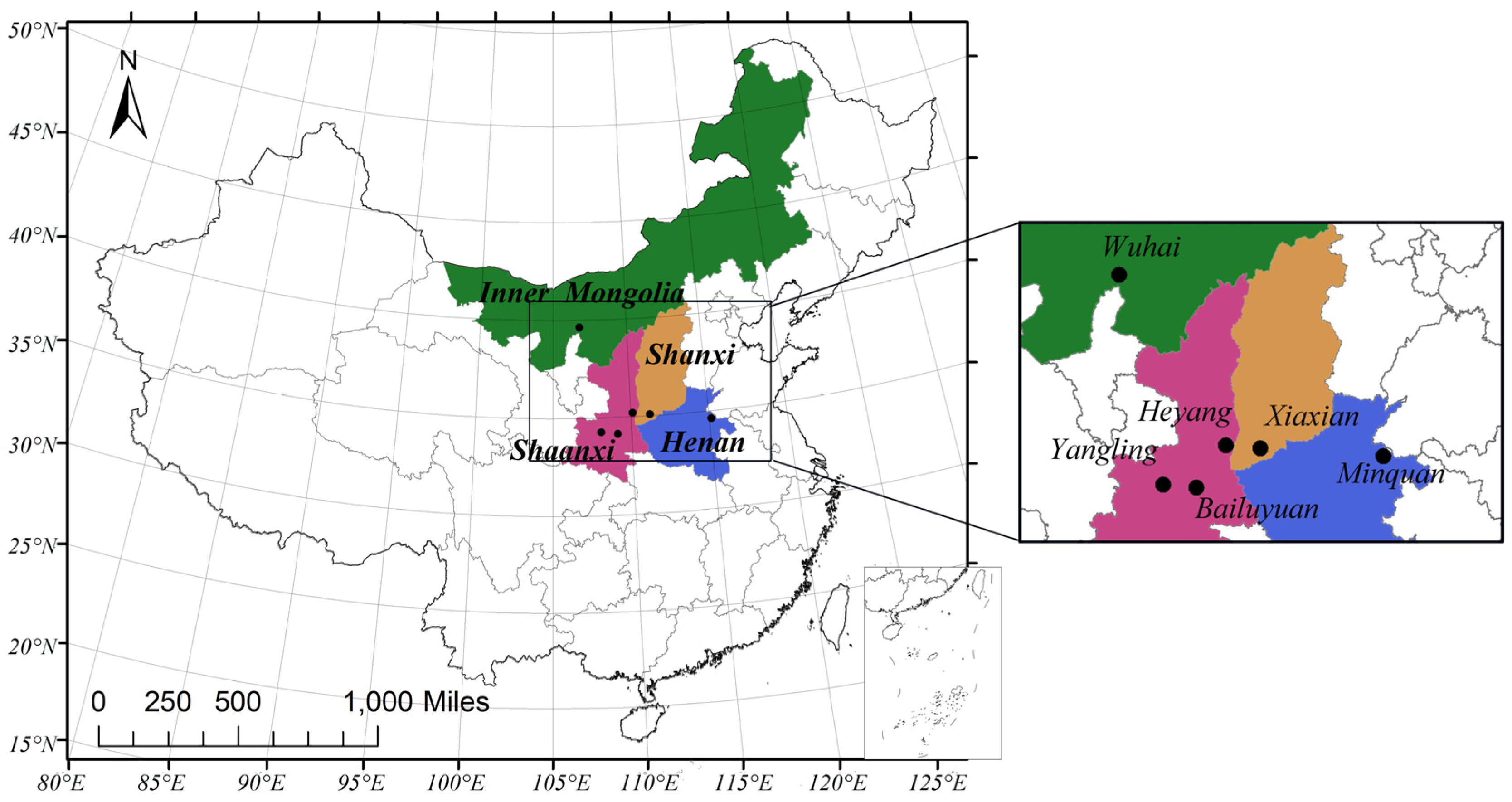
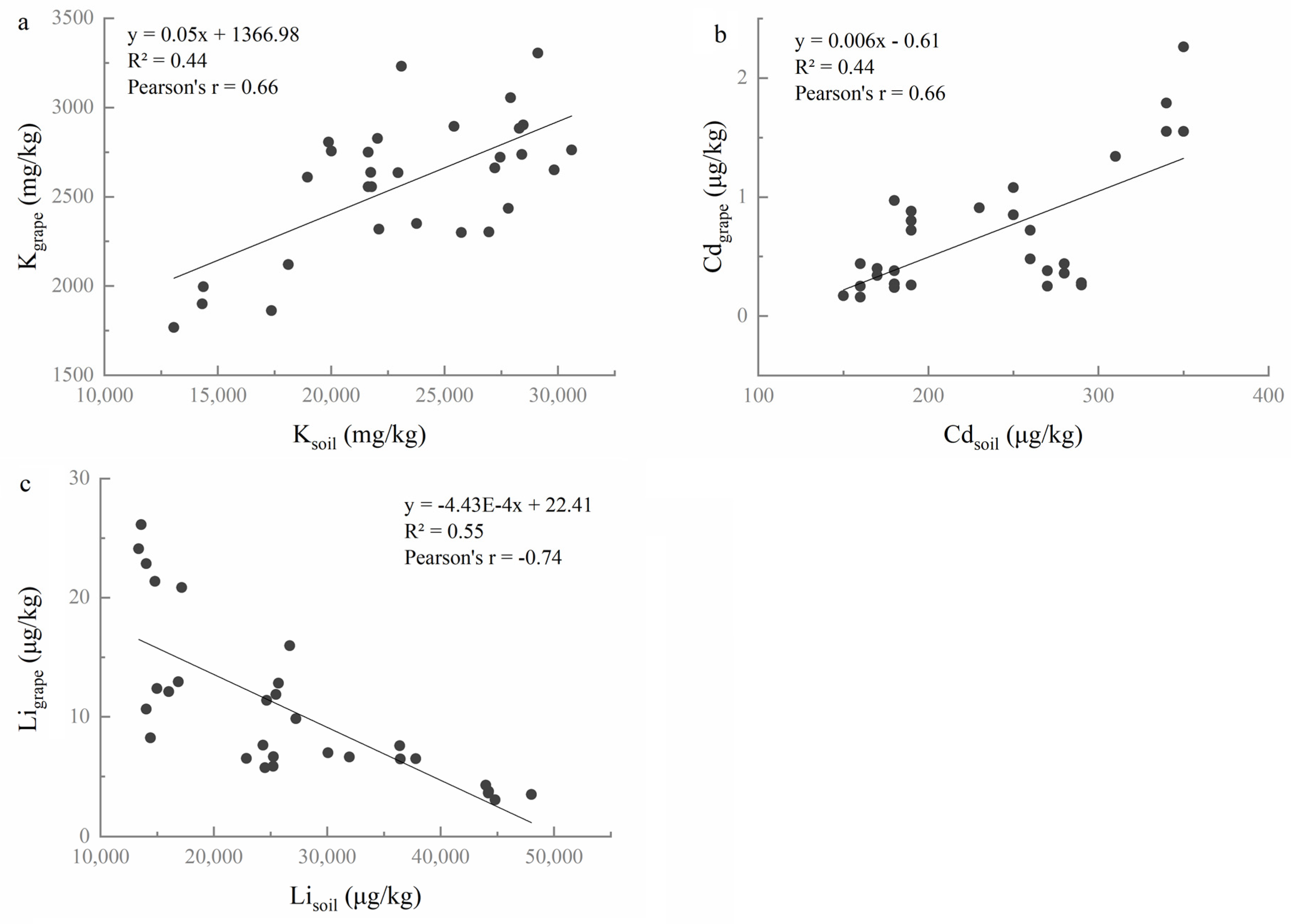
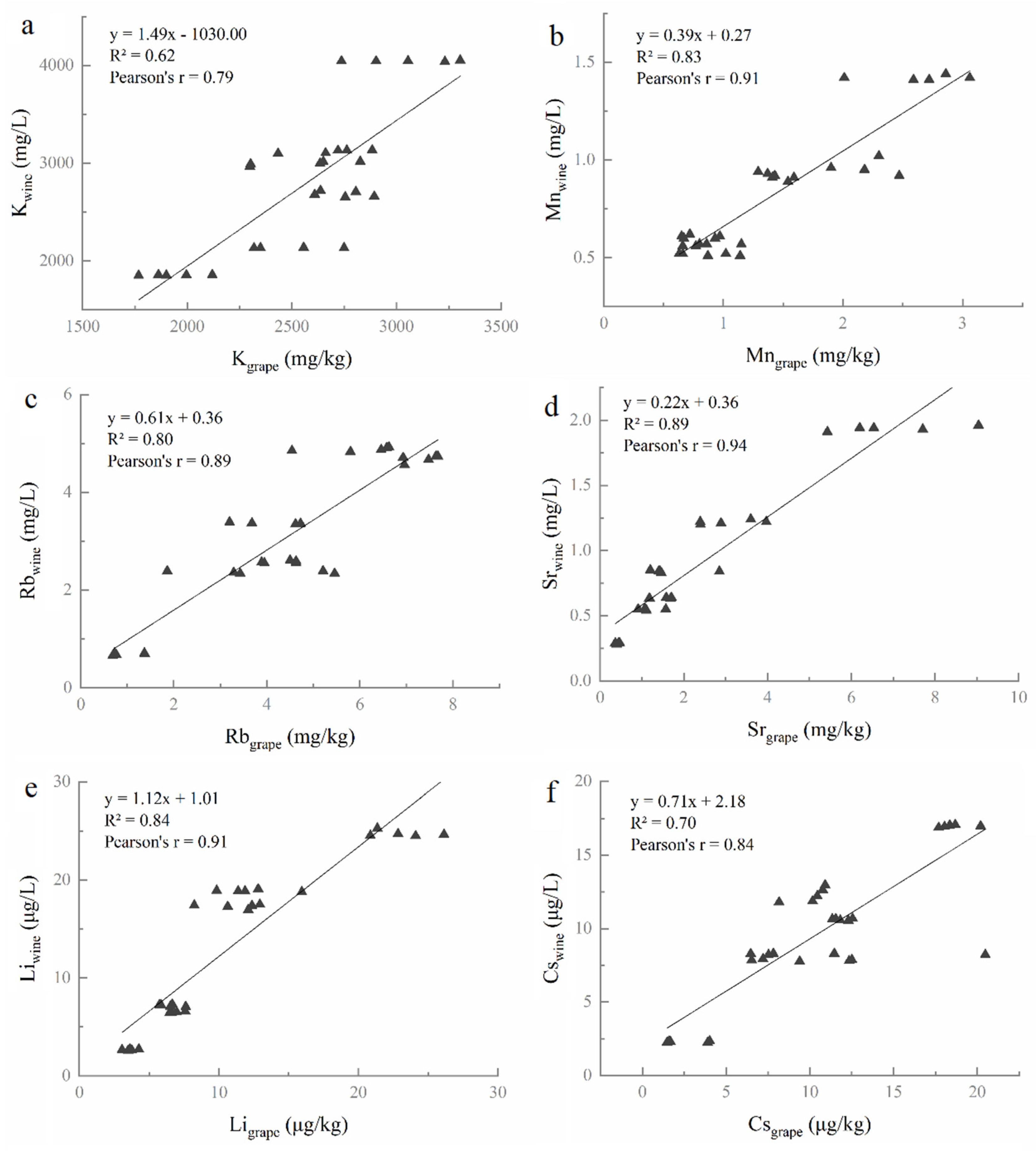
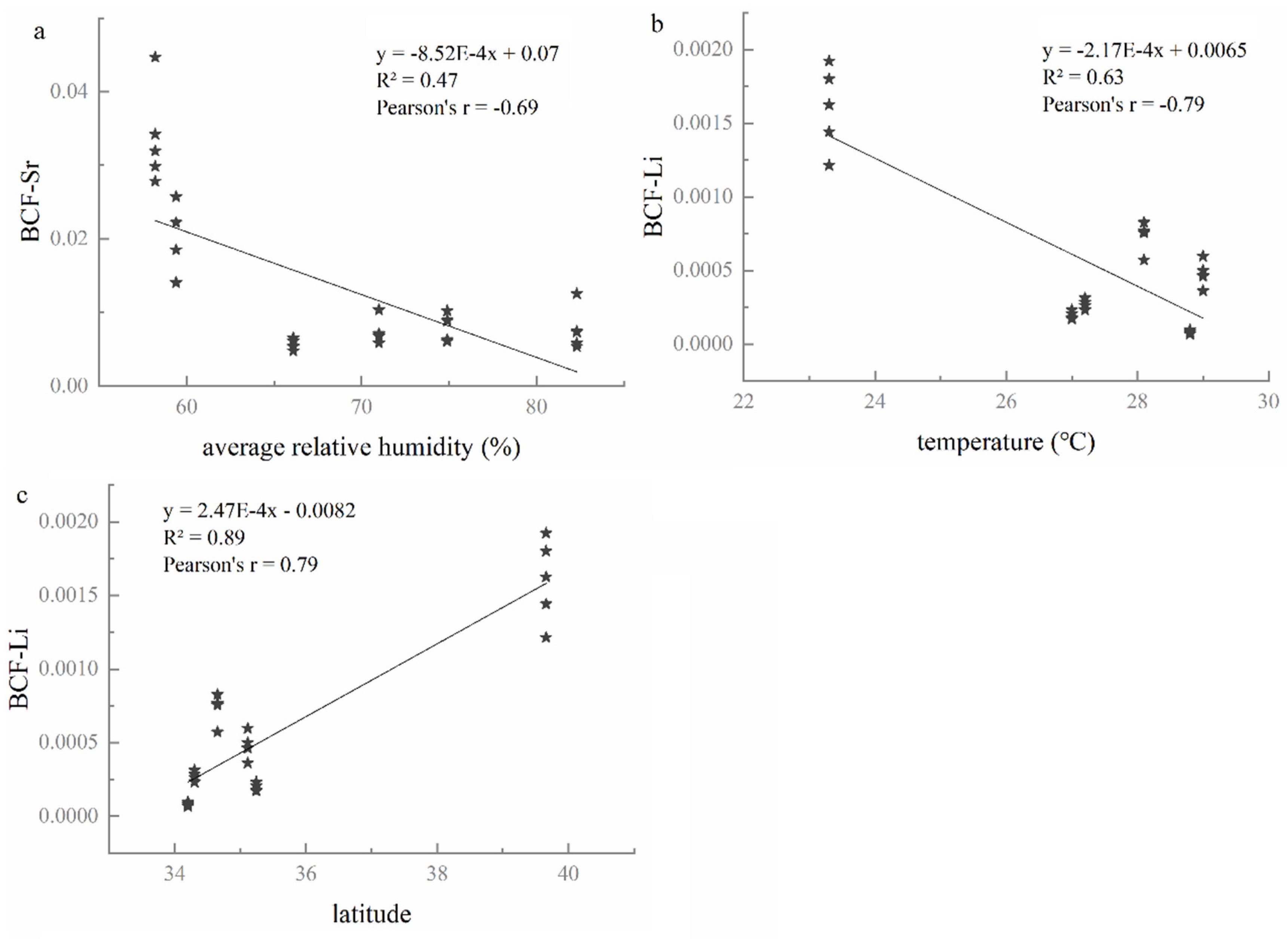
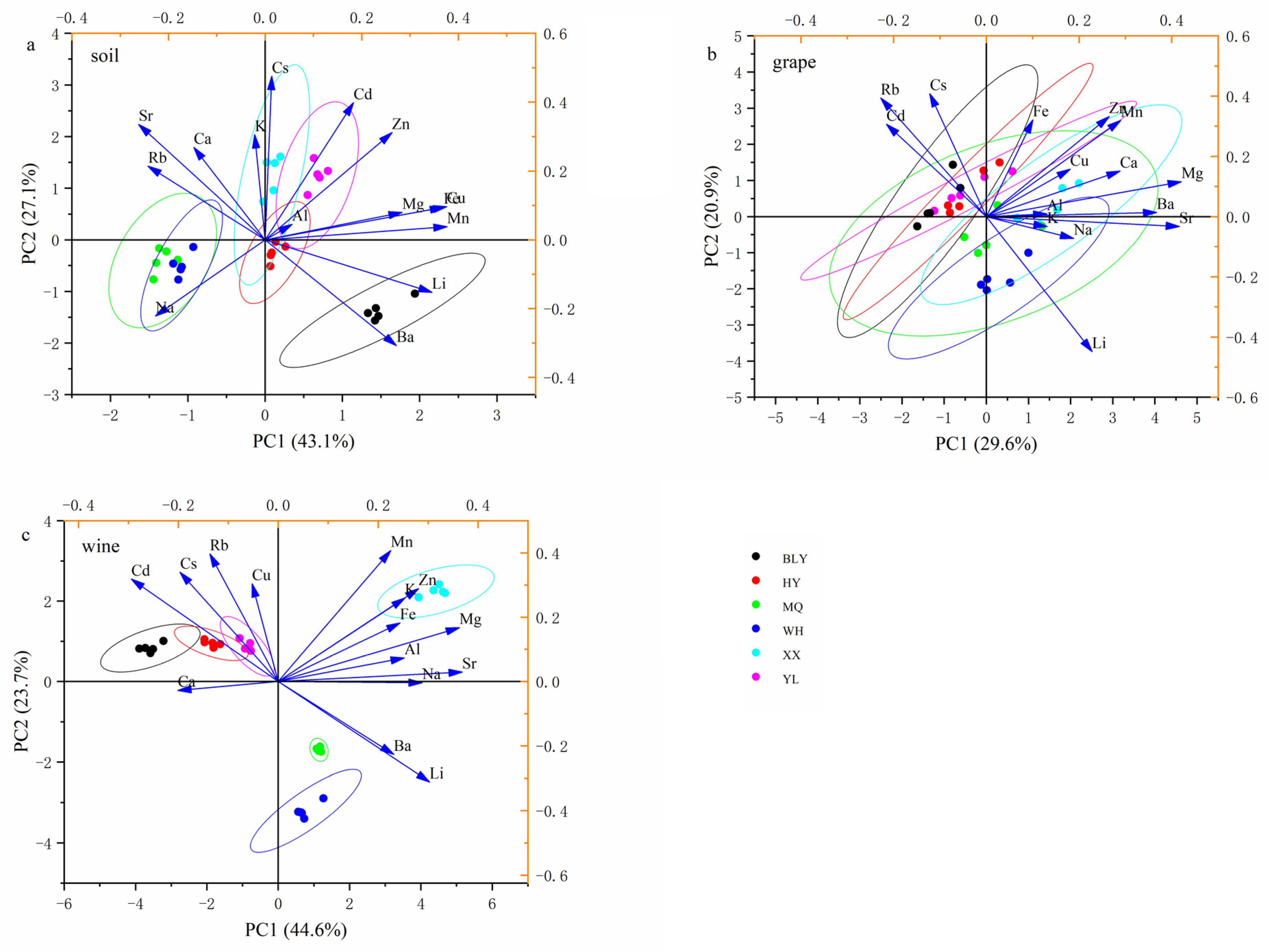
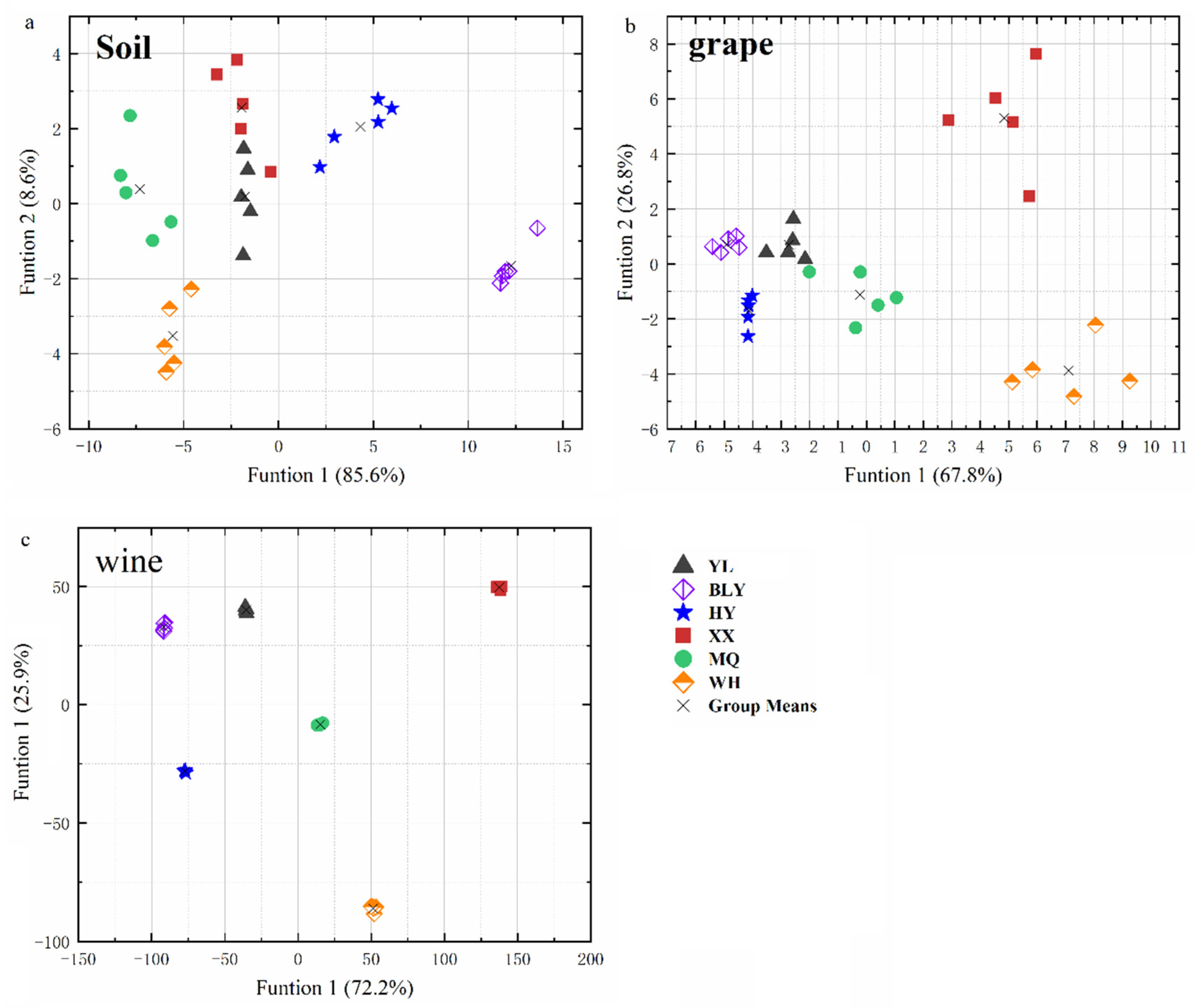
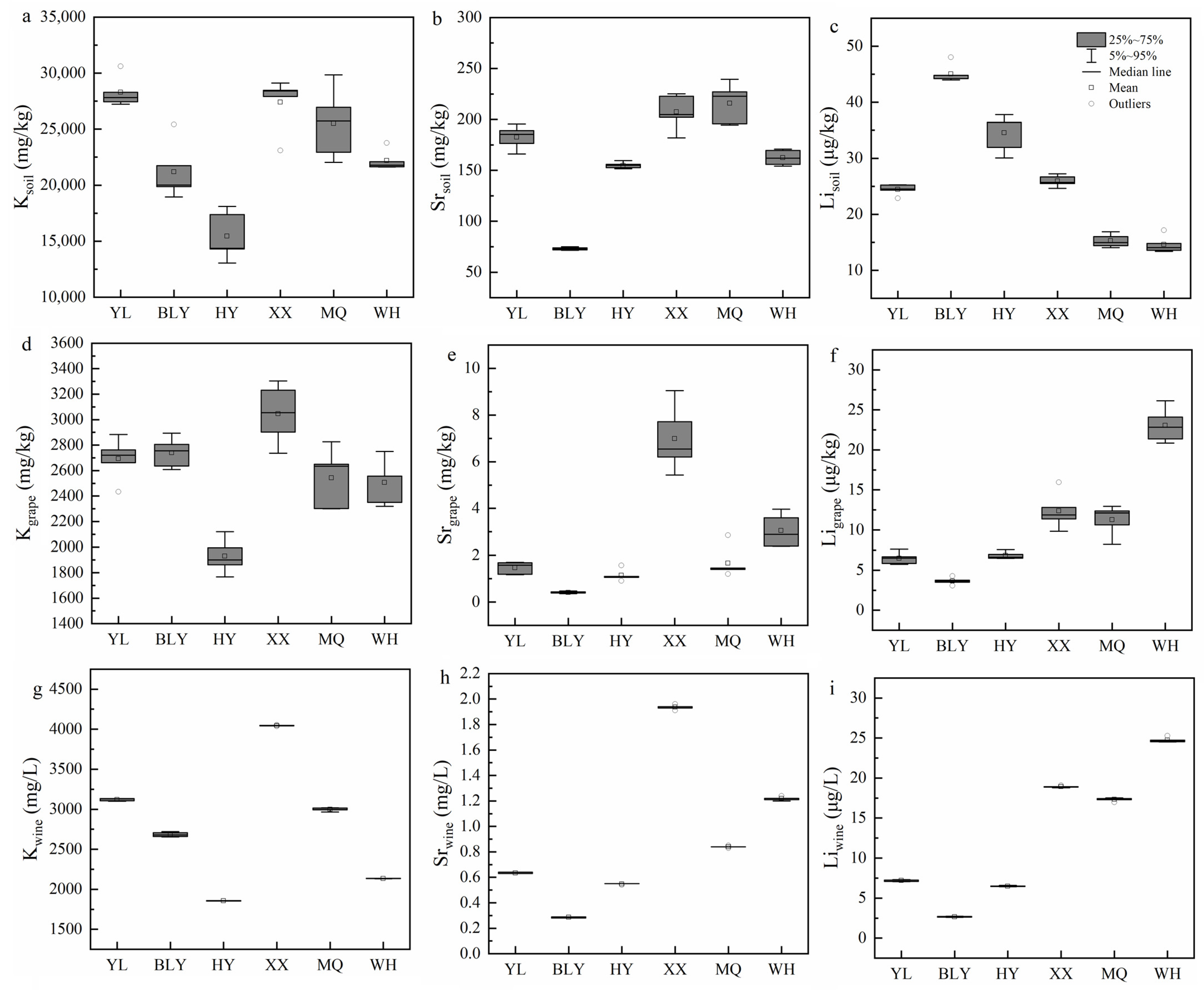
| Regions | Latitude | Longitude | Altitude (m) | Precipitation (mm) | Average Temperature (°C) | Average Relative Humidity (%) |
|---|---|---|---|---|---|---|
| Yangling, Shaanxi (YL) | 34.3 | 108.1 | 521 | 262.7 | 27.2 | 74.9 |
| Bailuyuan, Shaanxi (BLY) | 34.2 | 109.1 | 713 | 185.8 | 28.8 | 66.1 |
| Heyang, Shaanxi (HY) | 35.2 | 110.2 | 716 | 158 | 27 | 71 |
| Xia county, Shanxi (XX) | 35.1 | 111.2 | 402.9 | 66.6 | 29 | 58.2 |
| Minquan, Henan (MQ) | 34.7 | 115.2 | 60.6 | 538.8 | 28.1 | 82.3 |
| Wuhai, Inner Mongolia (WH) | 39.7 | 106.8 | 1105.6 | 171.1 | 23.3 | 59.4 |
| Element | YL | BLY | HY | XX | MQ | WH |
|---|---|---|---|---|---|---|
| Fe | 330,000 ± 1000 a | 36,000 ± 5600 a | 17,000 ± 2100 c | 25,000 ± 3300 b | 8800 ± 2300 d | 9300 ± 1600 d |
| K | 28,000 ± 1400 a | 21,000 ± 2600 b | 15,000 ± 2200 c | 27,000 ± 2400 a | 26,000 ± 3100 a | 22,000 ± 900 b |
| Ca | 22,000 ± 1200 a | 17,000 ± 2700 b | 23,000 ± 3500 a | 26,000 ± 5200 a | 23,000 ± 2800 a | 23,000 ± 3800 a |
| Al | 12,000 ± 6200 c | 19,000 ± 3000 ab | 5400 ± 1900 d | 20,000 ± 3600 a | 15,000 ± 1500 bc | 14,000 ± 1400 c |
| Na | 5300 ± 200 d | 6600 ± 800 b | 6400 ± 200 bc | 5900 ± 300 c | 9200 ± 500 a | 6700 ± 300 b |
| Mg | 4700 ± 500 b | 5800 ± 1400 a | 3000 ± 400 c | 5100 ± 600 ab | 3200 ± 400 c | 3400 ± 400 c |
| Mn | 700 ± 29 b | 800 ± 140 a | 540 ± 18 c | 560 ± 17 c | 360 ± 38 d | 330 ± 20 d |
| Sr | 180 ± 11 b | 73 ± 1.4 d | 160 ± 3.2 c | 210 ± 18 a | 220 ± 20 a | 160 ± 7.5 c |
| Zn | 80 ± 3.0 a | 62 ± 0.9 c | 73 ± 2.4 b | 72 ± 5.7 b | 48 ± 3.2 d | 46 ± 3.2 d |
| Rb | 32 ± 17 b | 6.4 ± 1.4 c | 10 ± 3.6 c | 65 ± 33 a | 57 ± 3.4 a | 57 ± 5.9 a |
| Li | 24 ± 1.0 c | 45 ± 1.7 a | 34 ± 3.3 b | 26 ± 1.0 c | 15 ± 1.2 d | 15 ± 1.5 d |
| Cu | 29 ± 1.3 a | 31 ± 0.9 a | 25 ± 1.4 b | 25 ± 2.5 b | 13 ± 2.5 c | 12 ± 1.2 c |
| Ba | 6.1 ± 1.1 b | 330 ± 12 a | 8.7 ± 1.3 b | 9.2 ± 4.8 b | 8.2 ± 0.6 b | 7.1 ± 0.9 b |
| Cs | 6.6 ± 0.4 a | 1.2 ± 0.3 d | 4.0 ± 0.7 b | 7.2 ± 1.8 a | 2.9 ± 0.4 c | 3.1 ± 0.4 bc |
| Cd | 0.34 ± 0.02 a | 0.20 ± 0.02 d | 0.26 ± 0.01 c | 0.28 ± 0.01 b | 0.17 ± 0.01 e | 0.17 ± 0.02 e |
| Element | YL | BLY | HY | XX | MQ | WH |
|---|---|---|---|---|---|---|
| K | 2700 ± 170 b | 2700 ± 120 b | 1900 ± 130 c | 3000 ± 230 a | 2500 ± 230 b | 2500 ± 180 b |
| Ca | 240 ± 93 a | 150 ± 42 a | 240 ± 83 a | 220 ± 53 a | 220 ± 85 a | 23 ± 62 a |
| Mg | 120 ± 41 b | 110 ± 16 b | 110 ± 25 b | 180 ± 18 a | 120 ± 28 b | 130 ± 22 b |
| Na | 3.3 ± 0.3 c | 3.2 ± 0.5 c | 3.8 ± 0.5 c | 7.8 ± 2.0 b | 13 ± 1.4 a | 3.6 ± 0.3 c |
| Fe | 6.9 ± 1.8 a | 6.3 ± 4.5 a | 6.7 ± 1.4 a | 6.3 ± 0.6 a | 6.2 ± 1.0 a | 5.2 ± 0.9 a |
| Rb | 6.0 ± 0.9 b | 7.3 ± 0.4 a | 4.3 ± 0.4 c | 4.2 ± 0.7 c | 3.9 ± 1.5 c | 1.0 ± 0.4 d |
| Cu | 2.6 ± 0.2 ab | 1.9 ± 0.3 b | 3.3 ± 3.2 ab | 4.5 ± 2.7 a | 2.5 ± 0.8 ab | 1.7 ± 0.3 b |
| Sr | 1.5 ± 0.3 c | 0.4 ± 0.04 d | 1.2 ± 0.2 cd | 7.0 ± 1.4 a | 1.7 ± 0.7 c | 3.0 ± 0.7 b |
| Mn | 1.8 ± 0.4 b | 0.9 ± 0.2 c | 1.7 ± 0.5 b | 2.7 ± 0.4 a | 0.8 ± 0.2 c | 0.9 ± 0.2 c |
| Zn | 1.3 ± 0.2 b | 1.5 ± 0.5 ab | 1.5 ± 0.4 ab | 1.8 ± 0.4 a | 1.4 ± 0.2 ab | 1.2 ± 0.3 b |
| Al | 1.2 ± 0.1 ab | 1.1 ± 0.2 b | 1.7 ± 0.6 a | 1.6 ± 0.3 a | 1.5 ± 0.1 ab | 1.3 ± 0.5 ab |
| Ba | 300 ± 120 ab | 100 ± 22 c | 180 ± 31 bc | 380 ± 110 a | 380 ± 180 a | 260 ± 23 ab |
| Li | 6.5 ± 0.8 c | 3.6 ± 0.4 d | 6.8 ± 0.5 c | 12 ± 2.3 b | 11 ± 1.9 b | 23 ± 2.1 a |
| Cs | 10 ± 1.1 b | 12 ± 0.5 b | 19 ± 1.0 a | 9.6 ± 2.8 b | 11 ± 5.8 b | 2.5 ± 1.3 c |
| Cd | 1.7 ± 0.4 a | 0.9 ± 0.1 b | 0.7 ± 0.3 b | 0.3 ± 0.1 c | 0.4 ± 0.1 c | 0.2 ± 0.0 c |
| Element | YL | BLY | HY | XX | MQ | WH |
|---|---|---|---|---|---|---|
| K | 3100 ± 16 b | 2700 ± 28 d | 1900 ± 3.0 f | 4000 ± 5.3 a | 3000 ± 21 c | 2100 ± 2.4 e |
| Mg | 180 ± 1.9 c | 150 ± 0.9 f | 170 ± 0.8 e | 250 ± 2.2 a | 200 ± 0.9 b | 180 ± 0.5 d |
| Ca | 120 ± 1.0 a | 92 ± 1.7 c | 120 ± 16 ab | 72 ± 1.4 d | 110 ± 0.4 b | 88 ± 0.2 c |
| Na | 6.2 ± 0.0 e | 6.9 ± 0.1 d | 5.8 ± 0.0 f | 18 ± 0.2 b | 20 ± 0.1 a | 7.4 ± 0.1 c |
| Rb | 4.9 ± 0.0 a | 4.7 ± 0.1 b | 2.6 ± 0.0 d | 3.4 ± 0.0 c | 2.4 ± 0.0 e | 0.7 ± 0.0 f |
| Fe | 2.0 ± 0.0 b | 1.1 ± 0.3 d | 2.0 ± 0.0 b | 2.2 ± 0.2 a | 1.6 ± 0.0 c | 1.6 ± 0.0 c |
| Zn | 1.4 ± 0.0 c | 0.71 ± 0.01 f | 1.5 ± 0.0 b | 2.1 ± 0.1 a | 1.3 ± 0.0 d | 0.98 ± 0.01 e |
| Sr | 0.63 ± 0.01 d | 0.29 ± 0.01 f | 0.55 ± 0.00 e | 1.9 ± 0.02 a | 0.84 ± 0.01 c | 1.2 ± 0.01 b |
| Mn | 0.95 ± 0.05 b | 0.57 ± 0.01 e | 0.92 ± 0.01 c | 1.4 ± 0.01 a | 0.61 ± 0.01 d | 0.52 ± 0.01 f |
| Al | 0.36 ± 0.01 b | 0.38 ± 0.09 b | 0.45 ± 0.05 b | 0.73 ± 0.27 a | 0.48 ± 0.01 b | 0.52 ± 0.22 b |
| Cu | 0.22 ± 0.00 e | 0.35 ± 0.01 a | 0.27 ± 0.01 c | 0.32 ± 0.01 b | 0.21 ± 0.00 f | 0.24 ± 0.01 d |
| Ba | 120 ± 0.6 b | 70 ± 1.0 f | 85 ± 0.4 e | 110 ± 0.2 d | 150 ± 1.0 a | 110 ± 0.9 c |
| Li | 7.2 ± 0.1 d | 2.7 ± 0.1 f | 6.5 ± 0.1 e | 19 ± 0.1 b | 17 ± 0.2 c | 25 ± 0.3 a |
| Cs | 12 ± 0.5 b | 11 ± 0.1 c | 17 ± 0.1 a | 7.8 ± 0.1 e | 8.3 ± 0.0 d | 2.3 ± 0.0 f |
| Cd | 0.36 ± 0.05 c | 0.56 ± 0.03 a | 0.45 ± 0.03 b | 0.56 ± 0.03 a | 0.22 ± 0.02 d | 0.14 ± 0.03 e |
Publisher’s Note: MDPI stays neutral with regard to jurisdictional claims in published maps and institutional affiliations. |
© 2021 by the authors. Licensee MDPI, Basel, Switzerland. This article is an open access article distributed under the terms and conditions of the Creative Commons Attribution (CC BY) license (https://creativecommons.org/licenses/by/4.0/).
Share and Cite
Hao, X.; Gao, F.; Wu, H.; Song, Y.; Zhang, L.; Li, H.; Wang, H. From Soil to Grape and Wine: Geographical Variations in Elemental Profiles in Different Chinese Regions. Foods 2021, 10, 3108. https://doi.org/10.3390/foods10123108
Hao X, Gao F, Wu H, Song Y, Zhang L, Li H, Wang H. From Soil to Grape and Wine: Geographical Variations in Elemental Profiles in Different Chinese Regions. Foods. 2021; 10(12):3108. https://doi.org/10.3390/foods10123108
Chicago/Turabian StyleHao, Xiaoyun, Feifei Gao, Hao Wu, Yangbo Song, Liang Zhang, Hua Li, and Hua Wang. 2021. "From Soil to Grape and Wine: Geographical Variations in Elemental Profiles in Different Chinese Regions" Foods 10, no. 12: 3108. https://doi.org/10.3390/foods10123108
APA StyleHao, X., Gao, F., Wu, H., Song, Y., Zhang, L., Li, H., & Wang, H. (2021). From Soil to Grape and Wine: Geographical Variations in Elemental Profiles in Different Chinese Regions. Foods, 10(12), 3108. https://doi.org/10.3390/foods10123108







